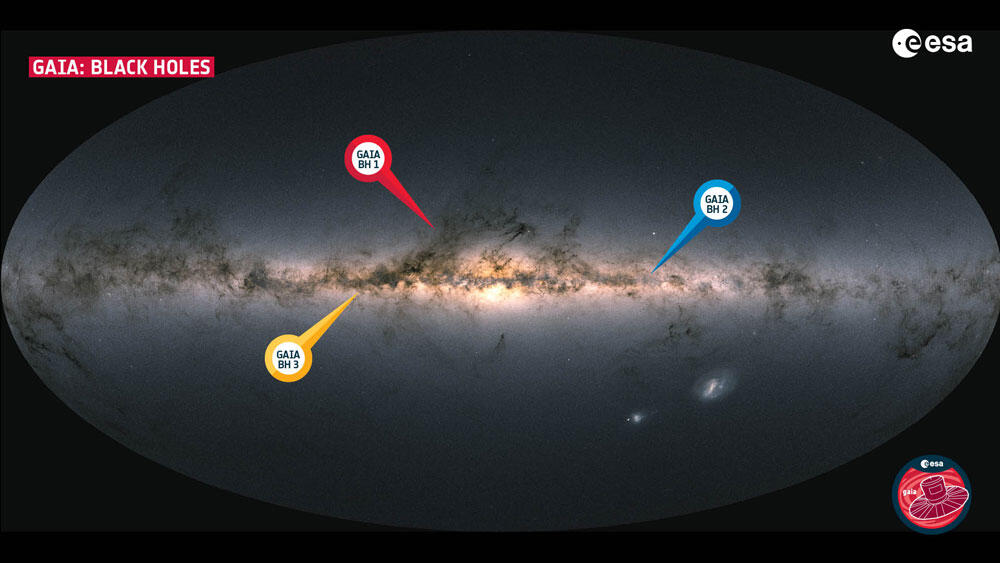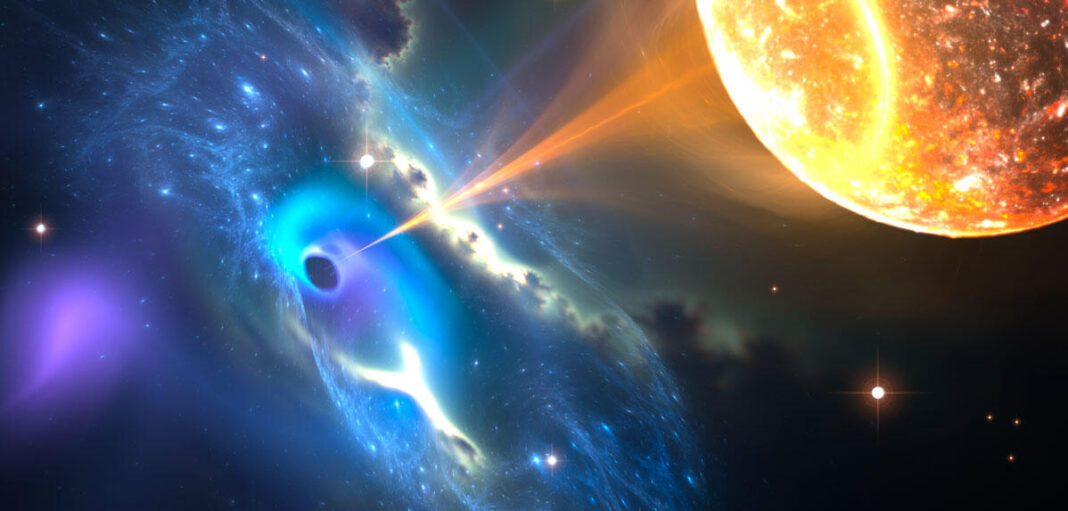Black holes are the monstrous cosmic giants present in the vastness of space, devouring everything in their path. If one were ever close enough, the idea that they could one day pull our entire planet into their abyss might have kept you up at night as a child.
Let me bring back a little of that fear. Scientists have just discovered the most massive stellar black hole ever found, and it is not as far away as you would hope—only 2,000 light-years from Earth. That is like having a giant, hungry neighbor down the street in cosmic terms.
What are Black Holes?
John Wheeler popularized the term black hole in 1967, describing a theoretical concept derived from Einstein’s General Theory of Relativity. Black holes were considered purely speculative until the 1960s when Robert J. Oppenheimer and others suggested they could be real physical entities rather than just mathematical abstractions.
Black holes are cosmic objects with extremely strong gravitational forces that light cannot escape their pull. They remain mysterious phenomena to this day. There are several varieties of black holes, including supermassive black holes, whose origins are still a mystery.
Sagittarius A* is a supermassive black hole located at the center of the Milky Way, theorized to have formed through the merging of multiple black holes or the remnants of successive supernovae. It was not formed directly from a stellar core collapse like Gaia BH3, a stellar black hole.

GAIA BH3
Gaia BH3 is the biggest stellar black hole recently discovered. European Southern Observatory confirmed this discovery on April 16, 2024. Its mass is equivalent to 33 solar masses. It is located in Aquila, the Eagle constellation. Astronomer Pasquale Panuzzo commented:” No one was expecting to find a high-mass black hole lurking nearby, undetected so far. This is the discovery you make once in your research life.”(Meet Gaia BH3, 2024).
Gaia BH3 is part of a binary star system with a low-metallicity star orbiting it. How can the star orbit the black hole without being engulfed by it? The answer lies in their distance; the star is too far away to be pulled into its event horizon allowing it to orbit safely. Such black holes are called dormant black holes, they do not radiate and lack accretion disks, so they remain hidden (Sleeping Giant Surprises Gaia Scientists, n.d.).
Wobbling star reveals its existence
Black holes cannot be observed directly but can be detected through their footprints or the signatures they leave behind. The term “black” reflects their nature—they do not emit any light.
Similarly, Gaia BH3 caused its companion star’s orbit to wobble, a motion detected by the Gaia spacecraft. The analysis of that data hinted at the presence of a cosmic object with gravity extreme enough to influence the star’s motion.
ESA confirmed it as the Milky Way’s biggest stellar black hole and the second closest to Earth. Carole Mundell, ESA Director of Science, commented on Gaia’s capabilities, “It is impressive to see the transformational impact Gaia is having on astronomy and astrophysics. Its discoveries have reached far beyond the original mission of creating an incredibly, precise map of over a billion stars in the Milky Way.”
DISCOVERY: The Gaia mission
The European Space Observatory launched the Gaia mission in 2013, to make a three-dimensional map of the universe. Another purpose was to collect data about the positions and radial velocities of stars and other cosmic objects to study their properties precisely. It can chart up to 1000 million stars accurately, enabling astronomers to conduct statistical analysis. This is indeed just 1 percent stars of the Milky Way (Prusti et al., 2016).
Gaia spacecraft is currently present at Lagrange-2 point and uses the principles of astrometry to observe the changes and velocities of cosmic objects; it is 200 times more accurate and produces data for more stars as compared to its predecessor Hipparcos(Gaia Overview, n.d.). Hipparcos was only able to chart the positions of 100,000 stars.
Jos de Bruijne, Gaia’s deputy project scientist at ESA, described the challenge as being “the same as if you are trying to tell the shape of a building while you are inside it.” He emphasized that understanding the galaxy’s shape requires knowing the exact positions of its stars, which are both very far apart and very distant from us. “To accurately measure their positions in three dimensions requires extreme precision,“ he added(published, 2022).
Gaia BH3 has shocked astronomers with its strangeness and the fact that it remained hidden for so long. However, the Gaia mission has changed all that—now it is all about knowing where to point your telescopes, as a famous quote in the world of astronomy goes. This mission still holds much promise, and future data releases are expected to bring more discoveries and secrets to uncover, such as the search for exoplanets.
The upcoming Gaia Data Release 4, New Star and Solar System Planetary Catalog anticipates uncovering numerous binary systems with dormant black hole companions. Each discovery will provide a chance to test different theories about how Gaia BH3 was formed. Astronomers are now focusing on preparing for the release of DR4 at the end of 2025.
Gaia’s discoveries continue to push the boundaries of what we know about the universe, and with every new release, our understanding of the cosmos grows even deeper.
Don’t you start panicking about Gaia BH3 pulling Earth into a cosmic abyss? That childhood fear of black holes gobbling up our planet? Yeah, this is not happening. It is still 2,000 light-years away, and Gaia BH3 isn’t exactly speeding our way. So, feel free to relax, take a breath, and enjoy your day— there’s no need to start preparing for an interstellar apocalypse yet!
References:
- Gaia mission detects the most massive black hole of stellar origin in the Milky Way. (n.d.). Current Events. Retrieved December 1, 2024, from https://web.ub.edu/web/actualitat/w/missio-gaia-forat-negre-massiu
- Gaia overview. (n.d.). Retrieved December 1, 2024, from https://www.esa.int/Science_Exploration/Space_Science/Gaia_overview
- Meet Gaia BH3, our galaxy’s most massive stellar black hole. (2024, April 17). https://earthsky.org/space/gaia-bh3-milky-ways-most-massive-stellar-black-hole/
- Prusti, T., Bruijne, J. H. J. de, Brown, A. G. A., Vallenari, A., Babusiaux, C., Bailer-Jones, C. a. L., Bastian, U., Biermann, M., Evans, D. W., Eyer, L., Jansen, F., Jordi, C., Klioner, S. A., Lammers, U., Lindegren, L., Luri, X., Mignard, F., Milligan, D. J., Panem, C., … Zschocke, S. (2016). The Gaia mission. Astronomy & Astrophysics, 595, A1. https://doi.org/10.1051/0004-6361/201629272
- published, T. P. from E. H. (2022, June 13). Gaia: Mapping a Billion Stars. Space.Com. https://www.space.com/41312-gaia-mission.html
- Sleeping giant surprises Gaia scientists. (n.d.). Retrieved December 1, 2024, from https://www.esa.int/Science_Exploration/Space_Science/Gaia/Sleeping_giant_surprises_Gaia_scientists
- Gaia. (n.d.). European Space Agency (ESA). Retrieved November 24, 2024, from https://www.esa.int/Science_Exploration/Space_Science/Gaia
- Panuzzo, P., Mazeh, T., Arenou, F., et al. (2024). Discovery of a dormant 33 solar-mass black hole in pre-release Gaia astrometry. Astronomy & Astrophysics, 686(L2). https://doi.org/10.1051/0004-6361/202449763
Also Read: THE FIRST PHOTO OF OUR MILKY WAY’S BLACK HOLE REVEALS

Zoha Imran is an undergraduate physics student from Peshawar with a strong passion for quantum information sciences. Zoha is dedicated to making science more accessible through her writings. She dives deep into quantum mechanics and enjoys exploring new ideas. She loves reading and expanding her knowledge on a variety of subjects.”

